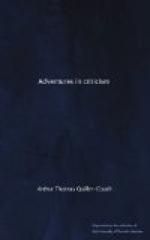This last sentence—if I remember rightly—was called a very bold one when it first appeared in print. To me it seems altogether moderate. Go steadily through Scott, and which of the novels can you choose to compare with the Cloister as a “vigorous, lifelike, and truthful picture of a time long gone by”?
Is it Ivanhoe?—a gay and beautiful romance, no doubt; but surely, as the late Mr. Freeman was at pains to point out, not a “lifelike and truthful picture” of any age that ever was. Is it Old Mortality? Well, but even if we here get something more like a “vigorous, lifelike, and truthful picture of a time gone by,” we are bound to consider the scale of the two books. Size counts, as Aristotle pointed out, and as we usually forget. It is the whole of Western Europe that Reade reconstructs for the groundwork of his simple story.
Mr. Besant might have said more. He might have pointed out that no novel of Scott’s approaches the Cloister in lofty humanity, in sublimity of pathos. The last fifty pages of the tale reach an elevation of feeling that Scott never touched or dreamed of touching. And the sentiment is sane and honest, too: the author reaches to the height of his great argument easily and without strain. It seems to me that, as an appeal to the feelings, the page that tells of Margaret’s death is the finest thing in fiction. It appeals for a score of reasons, and each reason is a noble one. We have brought together in that page extreme love, self-sacrifice, resignation, courage, religious feeling: we have the end of a beautiful love-tale, the end of a good woman, and the last earthly trial of a good man. And with all this, there is no vulgarization of sacred ground, no cheap parade of the heart’s secrets; but a deep sobriety relieved with the most delicate humor. Moreover, the language is Charles Reade’s at its best—which is almost as good as at its worst it is abominable.
That Scott could never reach the emotional height of Margaret’s death-scene, or of the scene in Clement’s cave, is certain. Moreover in the Cloister Reade challenges comparison with Scott on Scott’s own ground—the ground of sustained adventurous narrative—and the advantage is not with Scott. Once more, take all the Waverley Novels and search them through for two passages to beat the adventures of Gerard and Denis the Burgundian (1) with the bear and (2) at “The Fair Star” Inn, by the Burgundian Frontier. I do not think you will succeed, even then. Indeed, I will go so far as to say that to match these adventures of Gerard and Denis you must go again to Charles Reade, to the homeward voyage of the Agra in Hard Cash. For these and for sundry other reasons which, for lack of space, cannot be unfolded here, The Cloister and the Hearth seems to me a finer achievement than the finest novel of Scott’s.




